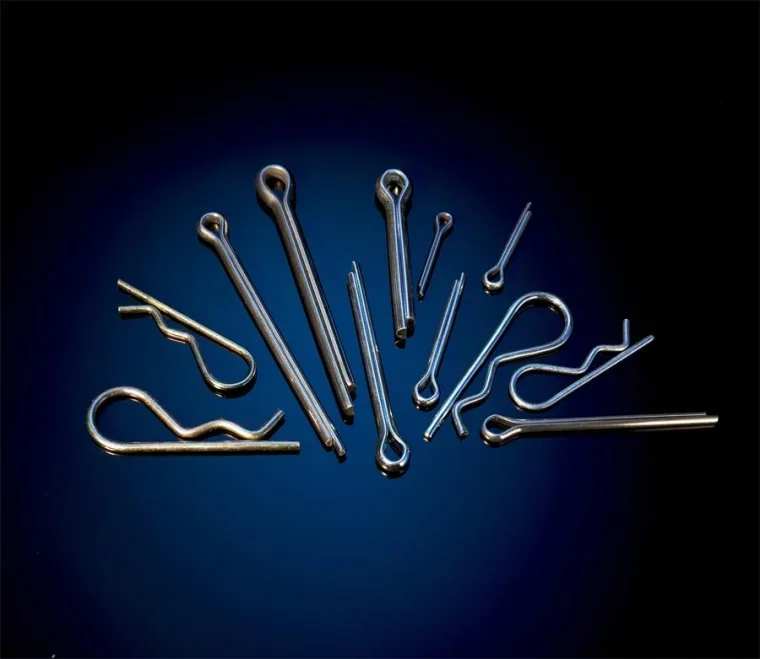Cotter pins, also known as split pins or cotter keys, are small metal fasteners that are commonly used in various applications to secure two components together. They are simple yet effective devices that play a crucial role in preventing unintended disassembly, ensuring safety, and maintaining the integrity of mechanical connections. In this blog, we will explore the purpose of cotter pins and discuss some important points to note when using them.
I. The Purpose of Cotter Pins
Cotter pins serve several important purposes in mechanical assemblies. Let's take a look at some of their key functions:
1.Securing Bolts and Nuts:
One of the primary purposes of cotter pins is to secure bolts and nuts in place. When a bolt passes through a hole and is secured with a nut, a cotter pin is inserted through a hole in the bolt, preventing the nut from loosening due to vibration or other external forces. This ensures that the connection remains secure and prevents accidents or damage that may occur due to loosening.
2.Preventing Rotation or Slippage:
Cotter pins are also used to prevent rotation or slippage of certain components. For example, in applications where a shaft or pin needs to remain stationary, a cotter pin can be inserted through a hole in the shaft, preventing it from rotating or sliding out of position.
3.Creating a Mechanical Lock:
Cotter pins are often used to create a mechanical lock that prevents unintended disassembly. By inserting a cotter pin through a hole in a fastener or component, it creates a physical barrier that stops the fastener from coming loose or the component from sliding out of place. This is particularly important in critical applications where safety and reliability are paramount.

II. Points to Note When Using Cotter Pins
While cotter pins are simple devices, there are some important points to consider when using them to ensure proper functionality and safety. Let's discuss some key considerations:
1.Correct Size and Type:
It is crucial to select the correct size and type of cotter pin for the application. Cotter pins are available in various sizes, diameters, and lengths. Choosing the right size ensures a proper fit, preventing the cotter pin from being too loose or too tight. Additionally, there are different types of cotter pins, such as hairpin cotter pins and extended prong cotter pins, each suitable for specific applications. Understanding the requirements of the assembly will help in selecting the appropriate cotter pin.
2.Proper Insertion and Bending:
When inserting a cotter pin, it is important to ensure that it is properly aligned with the holes in the fastener or component. Care should be taken to insert the cotter pin through the hole, allowing for enough length on each side to create the desired locking effect. After insertion, the ends of the cotter pin should be bent or spread apart to prevent it from sliding out. However, excessive bending or spreading can weaken the cotter pin, so it is important to strike the right balance.
3.Regular Inspection and Replacement:
Cotter pins, like any other mechanical device, can wear out over time or become damaged due to external factors. It is essential to regularly inspect cotter pins for signs of wear, corrosion, or bending. If any of these issues are identified, the cotter pin should be replaced immediately to maintain the integrity and safety of the assembly.
4.Consider Environmental Factors:
The environment in which the cotter pins are used can have an impact on their performance and longevity. Factors such as temperature, humidity, chemicals, and vibrations can affect the durability and effectiveness of cotter pins. It is important to consider these factors and select cotter pins that are suitable for the specific environmental conditions. In some cases, additional measures such as using corrosion-resistant materials or applying coatings may be necessary.

Conclusion
Cotter pins are simple yet indispensable devices that play a crucial role in securing mechanical assemblies and ensuring safety. Their ability to prevent unintended disassembly, secure bolts and nuts, and prevent rotation or slippage makes them essential in various applications. By understanding the purpose of cotter pins and following the points discussed above, you can effectively use cotter pins to maintain the integrity and reliability of your mechanical connections. Remember to choose the correct size and type, ensure proper insertion and bending, regularly inspect and replace worn or damaged cotter pins, and consider environmental factors. With these considerations in mind, cotter pins will continue to serve their purpose effectively, contributing to the safety and functionality of your assemblies.
Shanghai TianFang Fastener Co., Ltd. was established on 2006. Located in Shanghai Baoshan Industrial Park. We are a company specialized in the production and sales of fasteners and all kinds of punching products. We are committed to providing high-quality products and comprehensive solutions with a professional and efficient service attitude.
If you need fasteners solutions,welcome to contact us please.
Email:luluwu.tf@foxmail.com

